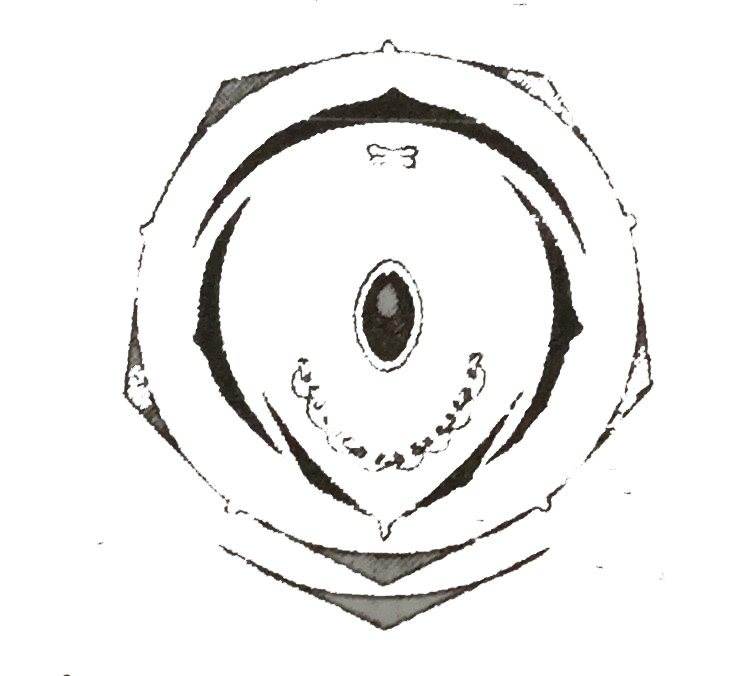Given below are a few floral formulae of some well known plants . Draw floral diagram from these formulae.
(i) o+ K_((5)) C_((5)) A_(5)
G_((underline2))
(ii) K(5)C1+2+2A(9)+1 G1–)
(iii) ⊕K5C5 A5+5G(5)
(i) Floral Formula ⊕ K(5)C(5)A5G2– represents flowers of Solanaceae family.

(ii) Floral Formula % K(5)C1+2+2A(9)+1G1 represents flowers of Fabaceae family.

(iii) 
Topper's Solved these Questions
- MORPHOLOGY OF FLOWERING PLANTSBOOK - NCERT EXEMPLARCHAPTER - MORPHOLOGY OF FLOWERING PLANTSEXERCISE - Long Answer Type Questions
8 Videos
- MORPHOLOGY OF FLOWERING PLANTSBOOK - NCERT EXEMPLARCHAPTER - MORPHOLOGY OF FLOWERING PLANTSEXERCISE - Very Short Answer Type Questions
10 Videos
- MINERAL NUTRITIONBOOK - NCERT EXEMPLARCHAPTER - MINERAL NUTRITIONEXERCISE - Long Answer Type Questions
8 Videos
- NEURAL CONTROL AND CO-ORDINATIONBOOK - NCERT EXEMPLARCHAPTER - NEURAL CONTROL AND CO-ORDINATIONEXERCISE - LONG ANSWER TYPE QUESTIONS
3 Videos
Similar Questions
Knowledge Check
To which family following floral formula is related?
Floral Formula : ⊕O+−K3+3A3+3G−(3)AFabaceaeBSolanaceaeCLiliaceaeDCruciferaeThe parietal floral formula of a flower is K(5) C5 A(oc) G(5). Which of the following set of Information is right?
AGamosepalous, polypetalous, syncarpous and superior ovaryBPolysepalous, monopetalous, gamocarpous and superior avaryCGamosepalous, gamopetalous, polycarpous and superior ovaryDGamosepalous, polypetalous, polycarpous and inferior ovaryThe C⌢(5)A5 condition is found in the floral formula or family
ALiliaceaeBPoaceaeCFabaceaeDSolanaceae
The given floral formula is exemplified by [%ma≤K5C1+2+(2)A9+1G1]
View SolutionThe C⌢(5)A5 condition is found in the floral formula or family
View Solutionwrite the structural formula for each of the following
a. A 3∘ amine with the formula C3H9N.
b. Three ethers with the formula C4H10O.
c. A 3∘ alcohol with the formula C4H8O.
d. Three 2∘ alky1 halides with the formula C5H11C1.
e. Three 1∘ alcohols with the formula C4H8O.
f. A 2∘ wiht the foumula C3H6O.
g. Two esters with the formula C3H6O.
g. Two esters with the formula C3H6O2.
h. Four 1∘ alky1 halides with the formula C5H11C1.
i. A 3∘ alky1 halide with the formula C5H11CI.
j. Three aldehydes with the formula C5H10O.
k. Three ketones with the formula C5H10O.
l. A2∘ amine with the formula C3H9N.
m. Two amides with the formula C2H5NO.
n. Two 1∘ amines with the formula C3H9N.
View SolutionThe equilibrium constant for the reaction? P4(s)+5O2(g)→ P4O10(s)
(A) kp=(1)/(p5o2)
(B) kp=p5o2
(C) kp=(PP4o10)/(pp4p5o2)
(D) kp=(pp4*p5o2)/(Pp4o10)]
View SolutionFor the reaction CO(g)+0.5O2(g)→CO2(g)KP/Kc is equal to
View Solution
